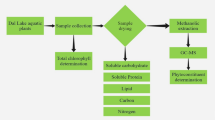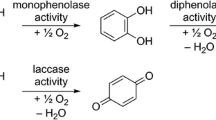Abstract
From screening 23 plant species, it was found that Pterocarpus indicus (C3) and Sansevieria trifasciata (crassulacean acid metabolism (CAM)) were the most effective in polar gaseous trimethylamine (TMA) uptake, reaching up to 90 % uptake of initial TMA (100 ppm) within 8 h, and could remove TMA at cycles 1–4 without affecting photosystem II (PSII) photochemistry. Up to 55 and 45 % of TMA was taken up by S. trifasciata stomata and leaf epicuticular wax, respectively. During cycles 1–4, interestingly, S. trifasciata changed its stomata apertures, which was directly induced by gaseous TMA and light treatments. In contrast, for P. indicus the leaf epicuticular wax and stem were the major pathways of TMA removal, followed by stomata; these pathways accounted for 46, 46, and 8 %, respectively, of TMA removal percentages. Fatty acids, particularly tetradecanoic (C14) acid and octadecanoic (C18) acid, were found to be the main cuticular wax components in both plants, and were associated with TMA removal ability. Moreover, the plants could degrade TMA via multiple metabolic pathways associated with carbon/nitrogen interactions. In CAM plants, one of the crucial pathways enabled 78 % of TMA to be transformed directly to dimethylamine (DMA) and methylamine (MA), which differed from C3 plant pathways. Various metabolites were also produced for further detoxification and mineralization so that TMA was completely degraded by plants.






Similar content being viewed by others
References
ACGIH (1991) Documentation of the threshold limit values and biological exposure indices (American Conference of Governmental Industrial Hygienists, ACGIH), 6th edn. Cincinnati, OH
Aydogan A, Montoya LD (2011) Formaldehyde removal by common indoor plant species and various growing media. Atmos Environ 45:2675–2682
Bakker M, Baas W, Sijm D, Kollöffel C (1998) Extraction and identification of leaf wax of L. sativa and P. major. Phytochemistry 47:1489–1493
Ceusters J, Borland AM, Godts C, Londers E, Croonenborghs S, Goethem DV, De Proft MP (2011) Crassulacean acid metabolism under severe light limitation: a matter of plasticity in the shadows? J Exp Bot 62:283–291
Ceusters J, Borland AM, Taybi T, Frans M, Godts C, De Proft MP (2014) Light quality modulates metabolic synchronization over the diel phases of crassulacean acid metabolism. J Exp Bot. doi:10.1093/jxb/eru185
Chang CT, Chen BY, Shiu IS, Jeng FT (2004) Biofiltration of trimethylamine-containing waste gas by entrapped mixed microbial cells. Chemosphere 55:751–756
Chien YC, Uang SN, Kuo CT, Shih TS, Jen JF (2000) Analytical method for monitoring airborne trimethylamine using solid phase micro-extraction and gas chromatography-flame ionization detection. Anal Chim Acta 419:73–79
Colby J, Zatman LJ (1973) Trimethylamine metabolism in obligate and facultative methylotrophs. Biochem J 132:101–112
Cordeiro SZ, Simas NK, Arruda RCCO, Sato A (2011) Composition of epicuticular wax layer of two species of Mandevilla (Apocynoideae, Apocynaceae) from Rio de Janeiro, Brazil. Biochem Syst Ecol 39:198–202
Cruz MD, Müller R, Svensmark B, Pedersen JS, Christensen JH (2014) Assessment of volatile organic compound removal by indoor plants—a novel experimental setup. Environ Sci Pollut Res 21:7838–7846
Dietrich P, Sanders D, Hedrich R (2001) The role of ion channels in light‐dependent stomatal opening. J Exp Bot 52:1959–1967
US EPA (2005) Toxicological review of n-hexane. The United States Environmental Protection Agency, Washington, DC
Fagerström A, Kocherbitov V, Westbye P, Bergström K, Mamontova V, Engblom J (2013) Characterization of a plant leaf cuticle model wax, phase behaviour of model wax–water systems. Thermochim Acta 571:42–52
Fernández V, Eichert T (2009) Uptake of hydrophilic solutes through plant leaves: current state of knowledge and perspectives of foliar fertilization. Plant Sci 28(1–2):36–68
Fernández-Escobar R, Antonaya-Baena MF, Sánchez-Zamora MA, Molina-Soria C (2014) The amount of nitrogen applied and nutritional status of olive plants affect nitrogen uptake efficiency. Sci Hort 167:1–4
Foyer CH, Noctor G, Hodges M (2011) Respiration and nitrogen assimilation: targeting mitochondria-associated metabolism as a means to enhance nitrogen use efficiency. Soc Exp Biol 62(4):1467–1482
Franco AC, Ball E, Lüttge U (1991) The influence of nitrogen, light and water stress on CO2 exchange and organic acid accumulation in the tropical C3–CAM tree, Clusia minor. J Exp Bot 42(5):597–603
Grams TEE, Thiel S (2002) High light-induced switch from C3-photosynthesis to Crassulacean acid metabolism is mediated by UV-A/blue light. J Exp Bot 53:1475–1483
Guieysse B, Hort C, Platel V, Munoz R, Ondarts M, Revah S (2008) Biological treatment of indoor air for VOC removal: potential and challenges. Biotechnol Adv 26:398–410
Hamamoto S, Uozumi N (2014) Organelle-localized potassium transport systems in plants. J Plant Physiol 171:743–747
Hodge DS, Devinny JS (1994) Biofilter treatment of ethanol vapors. Environ Prog 13(5):167–173
Hoshika Y, Omasa K, Paoletti E (2013) Both ozone exposure and soil water stress are able to induce stomatal sluggishness. Environ Exp Bot 88:19–23
Hu Y, Fernández V, Ma L (2014) Nitrate transporters in leaves and their potential roles in foliar uptake of nitrogen dioxide. Front Plant Sci. doi:10.3389/fpls.2014.00360
Ireland RJ, Lea PJ (1999) The enzymes of glutamine, glutamate, asparagine, and aspartate metabolism. In: Singh BK (ed) Plant amino acids, biochemistry and biotechnology. Marcel Dekker, New York, p 49–109
Jan LY, Jan YN (1997) Cloned potassium channels from eukaryotes and prokaryotes. Annu Rev Neurosci 20:91–123
Jetter R, Schaffer S (2001) Chemical composition of the Prunus laurocerasus leaf surface. Dynamic changes of the epicuticular wax film during leaf development. Plant Physiol 126:1725–1737
Juniper BE, Jeffree CE (1983) Plant surfaces. Edward Arnold, London, p 6
Kachroo A, Robin GP (2013) Systemic signaling during plant defense. Curr Opin Plant Biol 16:527–533
Kim SJ, Bae HS, Lee ST (2001) A novel denitrifying bacterial isolate that degrades trimethylamine both aerobically and anaerobically via two different pathways. Arch Microbiol 176(4):271–277
Kornas A, Schliebs EF, Lüttge U, Miszalski Z (2009) Adaptation of the obligate CAM plant Clusia alata to light stress: metabolic responses. J Plant Physiol 166:1914–1922
Kvesitadze E, Sadunishvili T, Kvesitadze G (2009) Mechanisms of organic contaminants uptake and degradation in plants. World Acad Sci Eng Technol 31:454–464
Lendzian KJ (2006) Survival strategies of plants during secondary growth: barrier properties of phellems and lenticels towards water, oxygen, and carbon dioxide. J Exp Bot 57(11):2535–2546
Leson G, Winer AM (1991) Biofiltration—an innovative air pollution control technology for VOC emission. J Air Waste Manage Assoc 41(11):1045–1054
Liu K, Fu H, Bei Q, Luan S (2000) Inward potassium channel in guard cells as a target for polyamine regulation of stomatal movements. Plant Physiol 124:1315–1325
Lüttge U (2004) Ecophysiology of Crassulacean acid metabolism (CAM). Ann Bot 93:629–652
Martin JT, Juniper BE (1970) The cuticles of plants. Edward Arnold, Edinburgh
Maxwell K, Johnson GN (2000) Chlorophyll fluorescence—a practical guide. J Exp Bot 51(345):659–668
Miszalski Z, Kornas A, Rozpadek P, Fischer-Schliebs E, Lüttge U (2013) Independent fluctuations of malate and citrate in the CAM species Clusia hilariana Schltdl. under low light and high light in relation to photoprotection. J Plant Physiol 170:453–458
Muller TE, Hultzsch KC, Yus M, Foubelo F, Tada M (2008) Hydroamination: direct addition of amines to alkenes and alkynes. Chem Rev 108:3795–3892
Nelson M, Wolverton BC (2011) Plants + soil/wetland microbes: food crop systems that also clean air and water. Adv Space Res 47:582–590
NIOSH (1981) Occupational health guidelines for chemical hazards. DHHS National Institute for Occupational Safety and Health (NIOSH) Publication, Cincinnati, pp 81–123
OSHA (1994) Occupational safety and health guideline for trimethylamine, computerized information system. U.S. Department of Labor, Washington, DC
Pate JS (1973) Uptake, assimilation and transport of nitrogen compounds by plants. Soil Biol Biochem 5(1):109–119
Pattabiraman VR, Bode JW (2011) Rethinking amide bond synthesis. Nature 480(7378):471–479
Percy KE, Manninen S, Häberle KH, Heerdt C, Werner H, Henderson GW, Matyssek R (2009) Effect of 3 years’ free-air exposure to elevated ozone on mature Norway spruce (Picea abies (L.) Karst.) needle epicuticular wax physicochemical characteristics. Environ Pollut 157:1657–1665
Samanta TD, Ghosh T, Laskar S (2013) Variation of hydrocarbon constituents of epicuticular wax of leaves of Litchi chinensis Sonn. South Pac J Nat Appl Sci 31:73–79
Schonherr J (2006) Characterization of aqueous pores in plant cuticles and permeation of ionic solutes. J Exp Bot 57:2471–2491
Schreiber L (2005) Polar paths of diffusion across plant cuticles: New evidence for an Old hypothesis. Ann Bot 95:1069–1073
Schreiber L, Schönherr J (2009) Water and solute permeability of plant cuticles. Springer-Verlag Berlin Heidelberg, Germany
Seyyednejad SM, Koochak H (2013) Some morphological and biochemical responses due to industrial air pollution in Prosopis juliflora (Swartz) DC plant. Afr J Agric Res 8:1968–1974
Shah J (2009) Plants under attack: systemic signals in defence. Curr Opin Plant Biol 12:459–464
Sharma P, Pandey S (2014) Status of phytoremediation in world scenario. Int J Environ Biorem Biodegrad 2:178–191
Sharma T, Dreyer I, Riedelsberger J (2013) The role of K+ channels in uptake and redistribution of potassium in the model plant Arabidopsis thaliana. Front Plant Sci 4:1–16
Shieh WK, Keenan DJ (1986) Fluidized bed biofilm reactor for wastewater treatment. Adv Biochem Eng/Biotechnol 33(5):132–168
Soreanu G, Dixon M, Darlington A (2013) Botanical biofiltration of indoor gaseous pollutants—a mini-review. Chem Eng J 229:585–594
Sriprapat W, Thiravetyan P (2013) Phytoremediation of BTEX from indoor air by Zamioculcas zamiifolia. Water Air Soil Pollut 224:1482
Sriprapat W, Boraphech P, Thiravetyan P (2014a) Factors affecting xylene-contaminated air removal by the ornamental plant Zamioculcas zamiifolia. Environ Sci Pollut Res 21:2603–2610
Sriprapat W, Suksabye P, Areephak S, Klantup P, Waraha A, Sawattan A, Thiravetyan P (2014b) Uptake of toluene and ethylbenzene by plants: Removal of volatile indoor air contaminants. Ecotoxicol Environ Saf 102:147–151
Szafranek B, Tomaszewski D, Pokrzywińska K, Gołębiowski M (2008) Microstructure and chemical composition of leaf cuticular waxes in two salix species and their hybrid. Acta Biol Cracov Bot 50(2):49–54
Topp E, Scheunert I, Attar A, Korte F (1986) Factors affecting the uptake of C-14-labelled organic chemicals by plants from soil. Ecotoxicol Environ Saf 11:219–228
Treesubsuntorn C, Thiravetyan P (2012) Removal of benzene from indoor air by Dracaena sanderiana:eEffect of wax and stomata. Atmos Environ 57:317–321
Treesubsuntorn C, Suksabye P, Weangjun S, Pawana F, Thiravetyan P (2013) Benzene adsorption by plant leaf materials: effect of quantity and composition of wax. Water Air Soil Pollut 224:1736
Uscola M, Oliet JA, Villar-Salvador P, Díaz-Pinés E, Jacobs DF (2014a) Nitrogen form and concentration interact to affect the performance of two ecologically distinct Mediterranean forest trees. Eur J Forest Res 133:235–246
Uscola M, Villar-Salvador P, Oliet J, Warren CR (2014b) Foliar absorption and root translocation of nitrogen from different chemical forms in seedlings of two Mediterranean trees. Environ Exp Bot 104:34–43
Uzu G, Sobanska S, Sarret G, Muñoz M, Dumat C (2010) Foliar lead uptake by lettuce exposed to atmospheric fallouts. Environ Sci Technol 44:1036–1042
Walton TJ (1990) Wax, cutin and suberin. Methods Plant Biochem 4:105–158
WHO (2004) Chloroform (Concise International Chemical Assessment Document 58). World Health Organization, 1211, Geneva 27, Switzerland
Wolverton BC, Wolverton JD (1993) Plants and soil microorganisms; removal of formaldehyde, xylene and ammonia from the indoor environment. J Miss Acad Sci 38:11–15
Wolverton BC, McDonald RC, Watkins JE (1984) Foliage plants for removing indoor air pollutants from energy-efficient homes. Econ Bot 38:224–228
Yang DS, Pennisi SV, Son KC, Kays SJ (2009) Screening indoor plants for volatile organic pollutant removal efficiency. HortSci 44:1377–1381
Yurimoto H, Kato N, Sakai Y (2005) Assimilation, dissimilation, and detoxification of formaldehyde, a central metabolic intermediate of methylotrophic metabolism. Chem Rec 5:367–375
Zhang L, Zhang C, Cheng Z, Yao Y, Chen J (2013) Biodegradation of benzene, toluene, ethylbenzene, and o-xylene by the bacterium Mycobacterium cosmeticum byf-4. Chemosphere 90:1340–1347
Acknowledgments
The authors would like to thank the Thailand Research Fund through the Royal Golden Jubilee Ph.D. Program and King Mongkut’s University of Technology Thonburi for financially supporting Ms. Phattara Boraphech (grant No. PHD/0108/2553).
Conflict of interest
The authors declare that they have no conflict of interest.
Author information
Authors and Affiliations
Corresponding author
Additional information
Responsible editor: Philippe Garrigues
Electronic supplementary material
Below is the link to the electronic supplementary material.
ESM 1
(DOCX 55 kb)
Rights and permissions
About this article
Cite this article
Boraphech, P., Thiravetyan, P. Removal of trimethylamine (fishy odor) by C3 and CAM plants. Environ Sci Pollut Res 22, 11543–11557 (2015). https://doi.org/10.1007/s11356-015-4364-3
Received:
Accepted:
Published:
Issue Date:
DOI: https://doi.org/10.1007/s11356-015-4364-3




